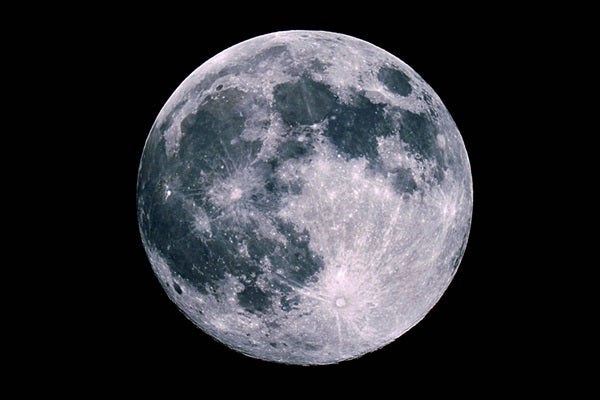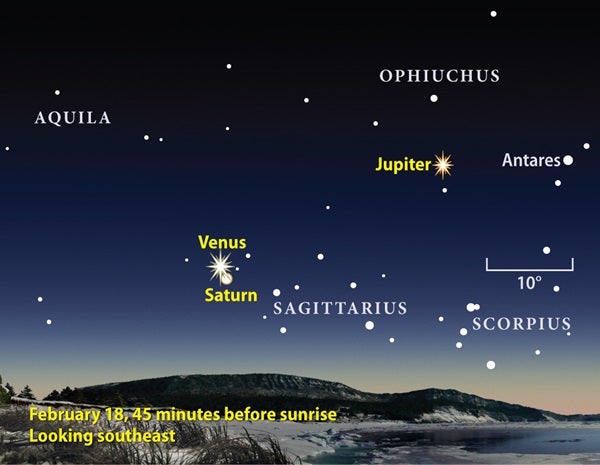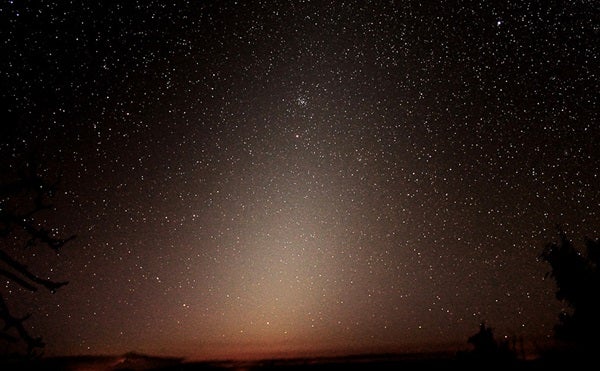Mercury returns to the evening sky in mid-February. Tonight, it appears 5° high in the west-southwest 30 minutes after sunset. It shines at magnitude –1.1, bright enough to show up against the twilight glow. (If you don’t see Mercury right away, binoculars will bring it into view.) A telescope reveals the planet’s disk, which spans 5.6″ and appears nearly full. The inner world is embarking on what will be its finest evening appearance of 2019. A week from now, it will appear twice as far above the western horizon a half-hour after the Sun goes down.
Saturday, February 16
Venus continues to dominate the predawn sky from its perch in northern Sagittarius. The inner world shines at magnitude –4.2, more than two magnitudes brighter than the second-brightest planet, Jupiter. Venus rises around 4:30 a.m. local time and stands nearly 15° high an hour before the Sun comes up. When viewed through a telescope, Venus shows a disk that spans 17″ and appears two-thirds lit.
Sunday, February 17
Mars continues to shine brightly on February evenings. Look for the Red Planet halfway to the zenith in the west-southwest as twilight fades to darkness. The world glows at magnitude 1.1 against the much dimmer stars of Aries the Ram. A telescope reveals the planet’s 6″-diameter disk, but you likely won’t see any surface details.
Venus and Saturn team up in the predawn sky early this week. Venus passes 1.1° due north of Saturn this morning, but the two bright planets lie within 2.5° of each other from February 16 to 20. Venus shines at magnitude –4.2, some 80 times brighter than magnitude 0.6 Saturn. Use your naked eye or binoculars for the best views of the stunning scene.
This is a good week to look for Sirius in the evening sky. The night sky’s brightest star (at magnitude –1.5) appears due south and at its highest position around 9 p.m. local time. It then lies about one-third of the way from the horizon to the zenith from mid-northern latitudes. (The farther south you live, the higher it appears.) For a few lucky observers this evening, however, Sirius should relinquish its crown as the brightest star when the 17th-magnitude asteroid 4388 Jurgenstock passes directly in front of it. Sirius will dim significantly — if not disappear — for 1.8 seconds. The event can be seen along a narrow path that stretches from near Cabo San Lucas, Mexico, to Winnipeg, Canada. (In the United States, it tracks through New Mexico, Colorado, Nebraska, and the Dakotas.) It occurs around 11:30 p.m. CST (10:30 p.m. MST). The precise track and time depend on the asteroid’s exact position. For the latest predictions, check out www.occultationpages.com/rasc/20190219_4388Jurgenstock.html. What might you see from the center line? Astronomers estimate that Sirius spans 0.006″ and the asteroid 0.005″. If accurate, this means Sirius will dim significantly but not disappear. But slight errors in those measurements could result in Sirius vanishing. In either case, it’s an event you won’t want to miss.
Tuesday, February 19
Full Moon occurs at 10:54 a.m. EST, but our satellite will look completely illuminated both before dawn and after sunset. The Moon spends this time among the background stars of Leo the Lion. Luna also reaches perigee today, at 4:03 a.m. EST, when it lies 221,681 miles (356,761 kilometers) from Earth. That makes this Full Moon the closest and biggest (33.2′ across) of 2019, and many people will feel compelled to call it a “Super Moon.”
Wednesday, February 20
You can use Mars as a guide to find Uranus through binoculars early this week. The two planets were in conjunction with each other a week ago and have started to separate, but they remain relatively close. This evening, Uranus lies 5° southwest of Mars. Don’t confuse magnitude 5.8 Uranus with a similarly bright star 0.5° to its northeast. The blue-green color of the planet should give it away.
February evenings offer a great opportunity to view the zodiacal light. From the Northern Hemisphere, late winter and early spring are the best times of year to observe this elusive glow after sunset. It appears slightly fainter than the Milky Way, so you’ll need a clear moonless sky and an observing site located far from the city. With the waning gibbous Moon now exiting the early evening sky, the next two weeks will be prime viewing times. Look for the cone-shaped glow, which has a broad base and points nearly straight up from the western horizon, after the last vestiges of twilight have faded away.
Friday, February 22
One of the sky’s largest asterisms — a recognizable pattern of stars separate from a constellation’s form — occupies center stage on February evenings. To trace the so-called Winter Hexagon, start with southern Orion’s luminary, Rigel. From there, the hexagon makes a clockwise loop. The second stop is brilliant Sirius in Canis Major. Next, pick up Procyon in the faint constellation Canis Minor, then the twins Castor and Pollux in Gemini, followed by Capella in Auriga, Aldebaran in Taurus, and finally back to Rigel.
Saturday, February 23
Jupiter continues to grow more prominent in the southeastern sky before dawn. The giant planet rises around 2:30 a.m. local time and climbs 20° high by the first hint of twilight. Jupiter gleams at magnitude –2.0, though it still pales in comparison to Venus, which rises two hours after the giant world. A telescope shows Jupiter’s 36″-diameter disk and at least two conspicuous cloud belts as well as the planet’s four bright Galilean moons.
Sunday, February 24
Two of the finest deep-sky objects shine prominently on February evenings. The Pleiades and Hyades star clusters appear highest in the south as darkness falls but remain conspicuous until well past midnight. The Pleiades, also known at the Seven Sisters and M45, looks like a small dipper to naked eyes. The larger Hyades forms the V-shaped head of Taurus the Bull. Although both look nice with naked eyes, binoculars show them best.












